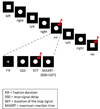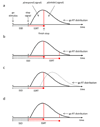Response inhibition in the stop-signal paradigm - PubMed (original) (raw)
Review
Response inhibition in the stop-signal paradigm
Frederick Verbruggen et al. Trends Cogn Sci. 2008 Nov.
Abstract
Response inhibition is a hallmark of executive control. The concept refers to the suppression of actions that are no longer required or that are inappropriate, which supports flexible and goal-directed behavior in ever-changing environments. The stop-signal paradigm is most suitable for the study of response inhibition in a laboratory setting. The paradigm has become increasingly popular in cognitive psychology, cognitive neuroscience and psychopathology. We review recent findings in the stop-signal literature with the specific aim of demonstrating how each of these different fields contributes to a better understanding of the processes involved in inhibiting a response and monitoring stopping performance, and more generally, discovering how behavior is controlled.
Figures
Figure 1
Depiction of a trial course in the stop-signal paradigm. Tasks and task parameters in this figure are adapted from STOP-IT, which is a free-to-use stop-signal task program [74]. In the go task, subjects respond to the shape of a stimulus (a ‘square’ requires a left response and a ‘circle’ requires a right response). On one fourth of the trials, the go stimulus is followed by an auditory stop signal after a variable stop-signal delay (SSD). Subjects are instructed to respond as quickly and accurately as possible to the go stimulus on no-stop-signal trials. They are instructed to try to withhold their response on stop-signal trials, but not to wait for the stop signal to occur. On both no-stop-signal trials and stop-signal trials, the stimulus remains on the screen until subjects respond or until the maximal RT has elapsed.
Figure I (Box 1)
(A) Neural activity of FEF movement neurons on no-stop-signal trials and signal-inhibit trials [55]. (B) Neural activity in SEF neurons on no-stop-signal trials and signal-inhibit trials [Data provided by J.D. Schall]
Figure II (Box 2)
(A) Graphic representation of the assumptions of the independent race model [3], indicating how the probability of responding [p(respond|signal)] and the probability of inhibiting [p(inhibit|signal)] depend on stop-signal delay (SSD) (B), the distribution of go reaction times (C), and stop-signal reaction time (SSRT) (D). P(respond|signal) is represented by the area under the curve to the left of each red vertical line.
Figure III (Box 2)
Graphic representation of the assumptions of the interactive race model [64], indicating how go activation on a signal-inhibit trial is inhibited when the stop unit is activated.
Similar articles
- Comparing anticipatory and stop-signal response inhibition with a novel, open-source selective stopping toolbox.
Wadsley CG, Cirillo J, Nieuwenhuys A, Byblow WD. Wadsley CG, et al. Exp Brain Res. 2023 Feb;241(2):601-613. doi: 10.1007/s00221-022-06539-9. Epub 2023 Jan 13. Exp Brain Res. 2023. PMID: 36635589 Free PMC article. - Stop or stop-change--does it make any difference for the inhibition process?
Boecker M, Gauggel S, Drueke B. Boecker M, et al. Int J Psychophysiol. 2013 Mar;87(3):234-43. doi: 10.1016/j.ijpsycho.2012.09.009. Epub 2012 Sep 28. Int J Psychophysiol. 2013. PMID: 23026439 - Does the stop-signal P3 reflect inhibitory control?
Hervault M, Soh C, Wessel JR. Hervault M, et al. Cortex. 2025 Feb;183:232-250. doi: 10.1016/j.cortex.2024.12.005. Epub 2024 Dec 21. Cortex. 2025. PMID: 39754857 Review. - Balancing cognitive demands: control adjustments in the stop-signal paradigm.
Bissett PG, Logan GD. Bissett PG, et al. J Exp Psychol Learn Mem Cogn. 2011 Mar;37(2):392-404. doi: 10.1037/a0021800. J Exp Psychol Learn Mem Cogn. 2011. PMID: 21171806 Free PMC article. - Inhibition and impulsivity: behavioral and neural basis of response control.
Bari A, Robbins TW. Bari A, et al. Prog Neurobiol. 2013 Sep;108:44-79. doi: 10.1016/j.pneurobio.2013.06.005. Epub 2013 Jul 13. Prog Neurobiol. 2013. PMID: 23856628 Review.
Cited by
- Event-related potentials in a two-choice oddball task of impaired behavioral inhibitory control among males with tendencies towards cybersex addiction.
Wang J, Dai B. Wang J, et al. J Behav Addict. 2020 Sep 8;9(3):785-796. doi: 10.1556/2006.2020.00059. Print 2020 Oct 12. J Behav Addict. 2020. PMID: 32903206 Free PMC article. - Response suppression by automatic retrieval of stimulus-stop association: evidence from transcranial magnetic stimulation.
Chiu YC, Aron AR, Verbruggen F. Chiu YC, et al. J Cogn Neurosci. 2012 Sep;24(9):1908-18. doi: 10.1162/jocn_a_00247. Epub 2012 May 25. J Cogn Neurosci. 2012. PMID: 22624606 Free PMC article. - Increased left inferior fronto-striatal activation during error monitoring after fMRI neurofeedback of right inferior frontal cortex in adolescents with attention deficit hyperactivity disorder.
Criaud M, Wulff M, Alegria AA, Barker GJ, Giampietro V, Rubia K. Criaud M, et al. Neuroimage Clin. 2020;27:102311. doi: 10.1016/j.nicl.2020.102311. Epub 2020 Jun 10. Neuroimage Clin. 2020. PMID: 32570204 Free PMC article. - The role of the right presupplementary motor area in stopping action: two studies with event-related transcranial magnetic stimulation.
Cai W, George JS, Verbruggen F, Chambers CD, Aron AR. Cai W, et al. J Neurophysiol. 2012 Jul;108(2):380-9. doi: 10.1152/jn.00132.2012. Epub 2012 Apr 18. J Neurophysiol. 2012. PMID: 22514296 Free PMC article. - Acute and chronic effects of cannabidiol on Δ⁹-tetrahydrocannabinol (Δ⁹-THC)-induced disruption in stop signal task performance.
Jacobs DS, Kohut SJ, Jiang S, Nikas SP, Makriyannis A, Bergman J. Jacobs DS, et al. Exp Clin Psychopharmacol. 2016 Oct;24(5):320-330. doi: 10.1037/pha0000081. Epub 2016 Aug 15. Exp Clin Psychopharmacol. 2016. PMID: 27690502 Free PMC article.
References
- Logan GD. On the ability to inhibit thought and action: A user’s guide to the stop signal paradigm. In: Dagenbach D, Carr TH, editors. Inhibitory processes in attention, memory and language. Academic; 1994.
- Logan GD, Cowan WB. On the ability to inhibit thought and action: A theory of an act of control. Psychological Review. 1984;91:295–327. - PubMed
- van den Wildenberg WPM, van der Molen MW. Developmental trends in simple and selective inhibition of compatible and incompatible responses. Journal of Experimental Child Psychology. 2004;87:201–220. - PubMed
- Williams BR, et al. Development of inhibitory control across the life span. Developmental Psychology. 1999;35:205–213. - PubMed
Publication types
MeSH terms
LinkOut - more resources
Full Text Sources
Other Literature Sources



